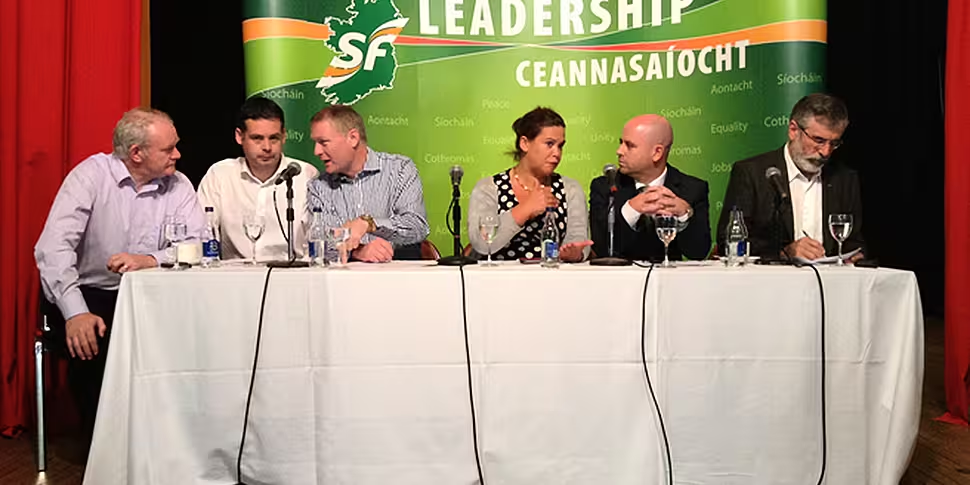You can’t talk about the rise of Sinn Féin, without first talking about the fall.
In a few weeks time, it’ll be the 90th anniversary of the party’s Ard Fheis that saw Eamon de Valera lose a vote on ending abstentionism and leaving Sinn Féin to set up Fianna Fáil.
The impact on what remained of the organisation was devastating. For the next eight decades, while FF dominated, Sinn Féin would be pushed to the margins of politics south of the border. There was the odd seat here or there but – aside from the election of two candidates under the ‘Anti H-Block’ banner in 1981 – it was utterly irrelevant to the national picture.
Even when the party started to make progress in the North, challenging the SDLP’s dominance of the Nationalist vote, there was still no traction south of the border.
But the IRA ceasefire brought a slow, steady rise in support for Sinn Féin. In 1997, Caoimhghín Ó Caoláin became the party’s first TD for 40 years and the first to take his seat since the Treaty split. By 2002, with the Good Friday Agreement in place, Dáil representation rose to five.
But despite widespread predictions it was the coming force, the party stalled, dropping a seat in 2007. However, Sinn Féin is nothing if not patient. Unlike any other political organisation, it thinks ‘long term’. Tiocfaidh ár lá.
Sure enough the economic and banking crash gave fresh impetus to the party. The 2011 general election saw 14 Sinn Féin TDs returned – including, what would once have seemed unthinkable, the party president Gerry Adams.
Sinn Féin was now within six seats of a beleaguered Fianna Fáil, prompting predictions that it would do to the Soldiers of Destiny what it did to the SDLP.
It hasn’t quite worked out like that – not yet anyway. The party has continued to grow and is poised to have a very good general election – one that would have been unimaginable twenty years ago.
However, given the crisis the country found itself in, and the extent of the austerity, there are grounds for arguing that Sinn Féin should be doing better than the 16-20% range they currently occupy in opinion polls.
Few, if any, pundits are predicting they’ll win more seats than Fianna Fáil. And the trend since last summer has been downward, as a series of controversies seem to have finally taken their toll on party support.
The PSNI’s assessment that the IRA’s organisational infrastructure continues to exist and the party leadership’s criticism of the existence of the Special Criminal Court, following Slab Murphy’s tax evasion conviction, have raised questions as to whether Sinn Féin has fully left behind its past and whether the Republican movement’s traditional ambivalence towards the institutions of the state still exists.
The party’s core vote – which is largely urban working class – looks unshakable. But the party remains toxic for many, particularly middle class, voters and that is putting a ceiling on its support levels.
The oft-expressed view in the media is that this will only change when Gerry Adams hands over the leadership mantle to a new generation. However, it was noticeable that Adams was not the only senior Sinn Féin figure to defend Murphy. Besides, Adams and Sinn Féin alone will decide when the time is right for a change at the top. No party is less influenced by what the media commentariat says.
That of course is an issue for day – right now the party’s formidable organisational structure is gearing up for the election and seat gains are inevitable.
The question is, how many? Some pundits believe the high twenties are a realistic target. The caveat is that Sinn Féin’s electoral performance tends to underperform its opinion poll ratings. The party’s unashamedly left wing policies may also prove less appealing outside of the big cities.
Dublin looks a particular stronghold and gains in Dublin Bay North, Mid-West, West look very likely and possibly also Fingal and Dublin Bay South on a good day.
Outside of Dublin, the party will be particularly targeting Galway West, Limerick City, Louth, Meath East, Waterford and Wicklow.
The ideal scenario for Sinn Féin would be a seat return well into the twenties, with Fianna Fáil going into government alongside Fine Gael, leaving it as the leader of the opposition.
Whether or not that happens, there is little doubt Sinn Féin, after so many decades out in the cold, is here to stay. They are hugely well financed and their members have a commitment to the cause that is rarely found in modern politics.
It’s possible to quibble about whether, given the economic circumstances, Sinn Féin should be further along the road to power. There are also genuine questions about the lingering influence of the hard men who fought the war in the days when the twin strategy was “the armalite in one hand and the ballot box in the other”.
But there is no disputing the enormous strides the party has made at the ballot box since the armalite was laid down. It won’t happen in 2016, but it’s now a matter of when, and not if, Sinn Féin is in government.









